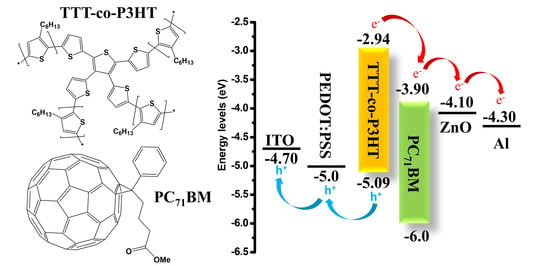Synthesis and Photovoltaics of Novel 2,3,4,5-Tetrathienylthiophene-co-poly(3-hexylthiophene-2,5-diyl) Donor Polymer for Organic Solar Cell
Abstract
1. Introduction
2. Experimental Section
2.1. Materials
2.2. Synthesis of 2,3,4,5-Tetrathienylthiophene (TTT)
2.3. Synthesis of TTT-co-P3HT
2.4. Characterization Techniques
2.5. Fabrication of OSCs
3. Results and Discussion
3.1. Optical and Electrochemical Characterization
3.2. Photovoltaic Properties
3.3. Characterization of OSCs with Electrochemical Methods
4. Conclusions
Supplementary Materials
Author Contributions
Funding
Conflicts of Interest
References
- Qing, L.; Zhong, A.; Chen, W.; Cao, Y.; Chen, J. Largely improved bulk-heterojunction morphology in organic solar cells based on a conjugated terpolymer donor via a ternary strategy. Polymer 2020, 186, 122050. [Google Scholar] [CrossRef]
- Genene, Z.; Negash, A.; Abdulahi, B.A.; Eachambadi, R.T.; Liu, Z.; Brande, N.V.D.; D’Haen, J.; Wang, E.; Vandewal, K.; Maes, W.; et al. Comparative study on the effects of alkylsilyl and alkylthio side chains on the performance of fullerene and non-fullerene polymer solar cells. Org. Electron. 2020, 77, 105572. [Google Scholar] [CrossRef]
- Li, X.; Li, K.; Su, D.; Shen, F.; Huo, S.; Fu, H.; Zhan, C. Design a thieno[3,2-b]thiophene bridged nonfullerene acceptor to increase open-circuit voltage, short-circuit current-density and fill factor via the ternary strategy. Chin. Chem. Lett. 2020, 31, 1243–1247. [Google Scholar] [CrossRef]
- Huang, K.; Li, M.; He, M.; Liang, Z.; Geng, Y. Difluorobenzoxadiazole-based conjugated polymers for efficient non-fullerene polymer solar cells with low voltage loss. Org. Electron. 2020, 77, 105541. [Google Scholar] [CrossRef]
- Li, T.; Chen, Z.; Wang, Y.; Tu, J.; Deng, X.; Li, Q.; Li, Z. Materials for interfaces in organic solar cells and photodetectors. ACS Appl. Mater. Interfaces 2019, 12, 3301–3326. [Google Scholar] [CrossRef] [PubMed]
- Chen, T.L.; Zhang, Y.; Smith, P.; Tamayo, A.; Liu, Y.; Ma, B. diketopyrrolopyrrole-containing oligothiophene-fullerene triads and their use in organic solar cells. ACS Appl. Mater. Interfaces 2011, 3, 2275–2280. [Google Scholar] [CrossRef]
- Niklas, J.; Zheng, T.; Nashchadin, A.; Mardis, K.L.; Yu, L.; Poluektov, O.G. Polaron and exciton delocalization in oligomers of high-performance polymer PTB7. J. Am. Chem. Soc. 2019, 142, 1359–1366. [Google Scholar] [CrossRef]
- Liang, Y.; Wu, Y.; Feng, D.; Tsai, S.-T.; Son, H.-J.; Li, G.; Yu, L. Development of new semiconducting polymers for high performance solar cells. J. Am. Chem. Soc. 2009, 131, 56–57. [Google Scholar] [CrossRef]
- Ranjitha, A.; Thambidurai, M.; Shini, F.; Muthukumarasamy, N.; Velauthapillai, D. Effect of doped TiO2 film as electron transport layer for inverted organic solar cell. Mater. Sci. Energy Technol. 2019, 2, 385–388. [Google Scholar] [CrossRef]
- Revoju, S.; Biswas, S.; Eliasson, B.; Sharma, G.D. Effect of acceptor strength on optical, electrochemical and photovoltaic properties of phenothiazine-based small molecule for bulk heterojunction organic solar cells. Dye. Pigment. 2018, 149, 830–842. [Google Scholar] [CrossRef]
- Cui, Y.; Yao, H.; Zhang, J.; Zhang, T.; Wang, Y.; Hong, L.; Xian, K.; Xu, B.; Zhang, S.; Peng, J.; et al. Over 16% efficiency organic photovoltaic cells enabled by a chlorinated acceptor with increased open-circuit voltages. Nat. Commun. 2019, 10, 2515. [Google Scholar] [CrossRef] [PubMed]
- Zhao, W.; Li, S.; Yao, H.; Zhang, S.; Zhang, Y.; Yang, B.; Hou, J. Molecular optimization enables over 13% efficiency in organic solar cells. J. Am. Chem. Soc. 2017, 139, 7148–7151. [Google Scholar] [CrossRef] [PubMed]
- Li, S.; Ye, L.; Zhao, W.; Zhang, S.; Mukherjee, S.; Ade, H.; Hou, J. Energy-level modulation of small-molecule electron acceptors to achieve over 12% efficiency in polymer solar cells. Adv. Mater. 2016, 28, 9423–9429. [Google Scholar] [CrossRef] [PubMed]
- Ansari, M.A.; Mohiuddin, S.; Kandemirli, F.; Malik, M.I. Synthesis and characterization of poly(3-hexylthiophene): Improvement of regioregularity and energy band gap. RSC Adv. 2018, 8, 8319–8328. [Google Scholar] [CrossRef]
- Wang, W.; Zhang, G.; Guo, J.; Gu, Z.; Hao, R.; Lin, Z.; Qian, Y.; Zhu, M.; Xia, H.; Peng, Q.; et al. Medium-bandgap (acceptor′–donor)2acceptor-type small-molecule donors based on an asymmetric thieno[3,2-c]isochromene building block for organic solar cells with high efficiency and voltage. ACS Appl. Energy Mater. 2019, 2, 4730–4736. [Google Scholar] [CrossRef]
- Katsumata, S.; Isegawa, T.; Okamoto, T.; Kubo, W. Effect of metamaterial perfect absorber on device performance of PCPDTBT:PC 71 BM Solar Cell. Phys. Status Solidi (a) 2019, 217, 1900910. [Google Scholar] [CrossRef]
- Kesters, J.; Verstappen, P.; Raymakers, J.; Vanormelingen, W.; Drijkoningen, J.; D’Haen, J.; Manca, J.V.; Lutsen, L.; Vanderzande, D.; Maes, W. Enhanced Organic Solar Cell Stability by Polymer (PCPDTBT) Side Chain Functionalization. Chem. Mater. 2015, 27, 1332–1341. [Google Scholar] [CrossRef]
- Liu, J.; Zhu, X.; Li, J.; Shen, J.; Tu, G. Enhancing the thermal stability of the bulk-heterojunction photovoltaics based on P3HT/PCBM by incorporating diblock amphipathic P3HT–PEO at D/A interface. RSC Adv. 2016, 6, 61934–61943. [Google Scholar] [CrossRef]
- Chen, Y.-H.; Huang, P.-T.; Lin, K.-C.; Huang, Y.-J.; Chen, C.-T. Stabilization of poly(3-hexylthiophene)/PCBM morphology by hydroxyl group end-functionalized P3HT and its application to polymer solar cells. Org. Electron. 2012, 13, 283–289. [Google Scholar] [CrossRef]
- Kim, J.S.; Lee, Y.; Lee, J.H.; Park, J.H.; Kim, J.K.; Cho, K. High-efficiency organic solar cells based on end-functional-group-modified poly(3-hexylthiophene). Adv. Mater. 2010, 22, 1355–1360. [Google Scholar] [CrossRef]
- Seibers, Z.D.; Collier, G.S.; Hopkins, B.W.; Boone, E.S.; Le, T.P.; Gomez, E.D.; Kilbey, S.M. Tuning fullerene miscibility with porphyrin-terminated P3HTs in bulk heterojunction blends. Soft Matter 2020, 16, 9769–9779. [Google Scholar] [CrossRef] [PubMed]
- Lim, B.; Jo, J.; Na, S.-I.; Kim, J.; Kim, S.-S.; Kim, D.-Y. A morphology controller for high-efficiency bulk-heterojunction polymer solar cells. J. Mater. Chem. 2010, 20, 10919–10923. [Google Scholar] [CrossRef]
- Tanaka, S.; Rosli, S.K.B.; Takada, K.; Taniai, N.; Yoshitomi, T.; Ando, H.; Matsumoto, K. Effects of bromination of poly(3-hexylthiophene) on the performance of bulk heterojunction solar cells. RSC Adv. 2017, 7, 46874–46880. [Google Scholar] [CrossRef]
- Liu, R.; Liu, Z. Polythiophene: Synthesis in aqueous medium and controllable morphology. Sci. Bull. 2009, 54, 2028–2032. [Google Scholar] [CrossRef]
- Rassie, C.; Olowu, R.A.; Waryo, T.T.; Wilson, L.; Williams, A.; Baker, P.G.; Iwuoha, E.I. Dendritic 7T-polythiophene electro-catalytic sensor system for the determination of polycyclic aromatic hydrocarbons. Int. J. Electrochem. Sci. 2011, 6, 1949–1967. Available online: http://citeseerx.ist.psu.edu/viewdoc/download?doi=10.1.1.659.8116&rep=rep1&type=pdf (accessed on 11 March 2020).
- Tamanai, A.; Beck, S.; Pucci, A. Mid-infrared characterization of thiophene-based thin polymer films. Displays 2013, 34, 399–405. [Google Scholar] [CrossRef][Green Version]
- Hotta, S.; Rughooputh, S.D.D.V.; Heeger, A.J.; Wudl, F. Spectroscopic studies of soluble poly(3-alkylthienylenes). Macromolecules 1987, 20, 212–215. [Google Scholar] [CrossRef]
- Li, S.; Zhan, L.; Sun, C.; Zhu, H.; Zhou, G.; Yang, W.; Shi, M.; Li, C.-Z.; Hou, J.; Li, Y.; et al. Highly efficient fullerene-free organic solar cells operate at near zero highest occupied molecular orbital offsets. J. Am. Chem. Soc. 2019, 141, 3073–3082. [Google Scholar] [CrossRef]
- Zhang, J.; Liu, W.; Zhang, M.; Liu, Y.; Zhou, G.; Xu, S.; Zhang, F.; Zhu, H.; Liu, F.; Zhu, X. Revealing the critical role of the HOMO alignment on maximizing current extraction and suppressing energy loss in organic solar cells. iScience 2019, 19, 883–893. [Google Scholar] [CrossRef]
- Scharber, M.C.; Mühlbacher, D.; Koppe, M.; Denk, P.; Waldauf, C.; Heeger, A.J.; Brabec, C.J. Design rules for donors in bulk-heterojunction solar cells—Towards 10% energy-conversion efficiency. Adv. Mater. 2006, 18, 789–794. [Google Scholar] [CrossRef]
- Gadisa, A.; Svensson, M.; Andersson, M.R.; Inganäs, O. Correlation between oxidation potential and open-circuit voltage of composite solar cells based on blends of polythiophenes/ fullerene derivative. Appl. Phys. Lett. 2004, 84, 1609–1611. [Google Scholar] [CrossRef]
- Gao, B.; Yao, H.; Hong, L.; Hou, J. Efficient organic solar cells with a high open-circuit voltage of 1.34 V. Chin. J. Chem. 2019, 37, 1153–1157. [Google Scholar] [CrossRef]
- Huang, P.-T.; Huang, P.-F.; Horng, Y.-J.; Yang, C.-P. Photoluminescence study on charge transfer behavior of Poly(3-hexylthiophene) and PCBM blends. J. Chin. Chem. Soc. 2013, 60, 467–472. [Google Scholar] [CrossRef]
- Otieno, F.; Mutuma, B.K.; Airo, M.; Ranganathan, K.; Erasmus, R.; Coville, N.; Wamwangi, D. Enhancement of organic photovoltaic device performance via P3HT:PCBM solution heat treatment. Thin Solid Films 2017, 625, 62–69. [Google Scholar] [CrossRef]
- John, S.V.; Mayedwa, N.; Ikpo, C.; Molefe, L.; Ndipingwi, M.M.; Dywili, N.R.; Van Wyk, J.L.; Mapolie, S.; Baker, P.G.L.; Iwuoha, E. Photoluminescence quenching of poly(octylfluorenylbenzothiadiazole) luminophore by n-type cobalt(II) salicylaldimine metallodendrimer. Synth. Met. 2016, 220, 114–122. [Google Scholar] [CrossRef]
- Nismy, N.A.; Jayawardena, K.D.G.I.; Adikaari, A.A.D.T.; Silva, S.R.P. Photoluminescence quenching in carbon nanotube-polymer/fullerene films: Carbon nanotubes as exciton dissociation centres in organic photovoltaics. Adv. Mater. 2011, 23, 3796–3800. [Google Scholar] [CrossRef]
- Sun, Y.; Han, Y.; Liu, J. Controlling PCBM aggregation in P3HT/PCBM film by a selective solvent vapor annealing. Chin. Sci. Bull. 2013, 58, 2767–2774. [Google Scholar] [CrossRef]
- Abu-Zahra, N.; Algazzar, M. Effect of crystallinity on the performance of P3HT/PC70BM/n-Dodecylthiol polymer solar cells. J. Sol. Energy Eng. 2013, 136, 021023. [Google Scholar] [CrossRef]
- Glatthaar, M.; Riede, M.; Keegan, N.; Sylvester-Hvid, K.; Zimmermann, B.; Niggemann, M.; Hinsch, A.; Gombert, A. Efficiency limiting factors of organic bulk heterojunction solar cells identified by electrical impedance spectroscopy. Sol. Energy Mater. Sol. Cells 2007, 91, 390–393. [Google Scholar] [CrossRef]
- Norrman, K.; Krebs, F.C. Lifetimes of organic photovoltaics: Using TOF-SIMS and 18O2 isotopic labelling to characterise chemical degradation mechanisms. Sol. Energy Mater. Sol. Cells 2006, 90, 213–227. [Google Scholar] [CrossRef]
- Reese, M.O.; Nardes, A.M.; Rupert, B.L.; Larsen, R.E.; Olson, D.C.; Lloyd, M.T.; Shaheen, S.E.; Ginley, D.S.; Rumbles, G.; Kopidakis, N. Photoinduced Degradation of polymer and polymer-fullerene active layers: Experiment and theory. Adv. Funct. Mater. 2010, 20, 3476–3483. [Google Scholar] [CrossRef]
- Seemann, A.; Sauermann, T.; Lungenschmied, C.; Armbruster, O.; Bauer, S.; Egelhaaf, H.-J.; Hauch, J. Reversible and irreversible degradation of organic solar cell performance by oxygen. Sol. Energy 2011, 85, 1238–1249. [Google Scholar] [CrossRef]
- Cheng, P.; Zhan, X. Stability of organic solar cells: Challenges and strategies. Chem. Soc. Rev. 2016, 45, 2544–2582. [Google Scholar] [CrossRef] [PubMed]
- Campuzano, S.; Pedrero, M.; Montemayor, C.; Fatas, E.; Pingarrón, J.M.; Campuzano, S. Characterization of alkanethiol-self-assembled monolayers-modified gold electrodes by electrochemical impedance spectroscopy. J. Electroanal. Chem. 2006, 586, 112–121. [Google Scholar] [CrossRef]
- Ma, X.; Zhong, J.; Li, M.; Chen, J.; Zhang, Y.; Wu, S.; Gao, X.; Lu, X.; Liu, J.-M.; Liu, H. Hybrid solar cells using solution-processed TiO2 /Sb2S3 bilayer as electron transport layer. Sol. Energy 2016, 133, 103–110. [Google Scholar] [CrossRef]
- Xu, L.; Lee, Y.-J.; Hsu, J.W.P. Charge collection in bulk heterojunction organic photovoltaic devices: An impedance spectroscopy study. Appl. Phys. Lett. 2014, 105, 123904. [Google Scholar] [CrossRef]
- Zhang, Y.; Li, L.; Yuan, S.; Li, G.; Zhang, W. Electrical properties of the interfaces in bulk heterojunction organic solar cells investigated by electrochemical impedance spectroscopy. Electrochim. Acta 2013, 109, 221–225. [Google Scholar] [CrossRef]
- Janek, R.P.; Fawcett, W.R.; Ulman, A. Impedance Spectroscopy of Self-Assembled Monolayers on Au(111): Sodium ferrocyanide charge transfer at modified electrodes. Langmuir 1998, 14, 3011–3018. [Google Scholar] [CrossRef]
- Diao, P.; Guo, M.; Tong, R. Characterization of defects in the formation process of self-assembled thiol monolayers by electrochemical impedance spectroscopy. J. Electroanal. Chem. 2001, 495, 98–105. [Google Scholar] [CrossRef]
- Jorcin, J.-B.; Orazem, M.E.; Pébère, N.; Tribollet, B. CPE analysis by local electrochemical impedance spectroscopy. Electrochim. Acta 2006, 51, 1473–1479. [Google Scholar] [CrossRef]



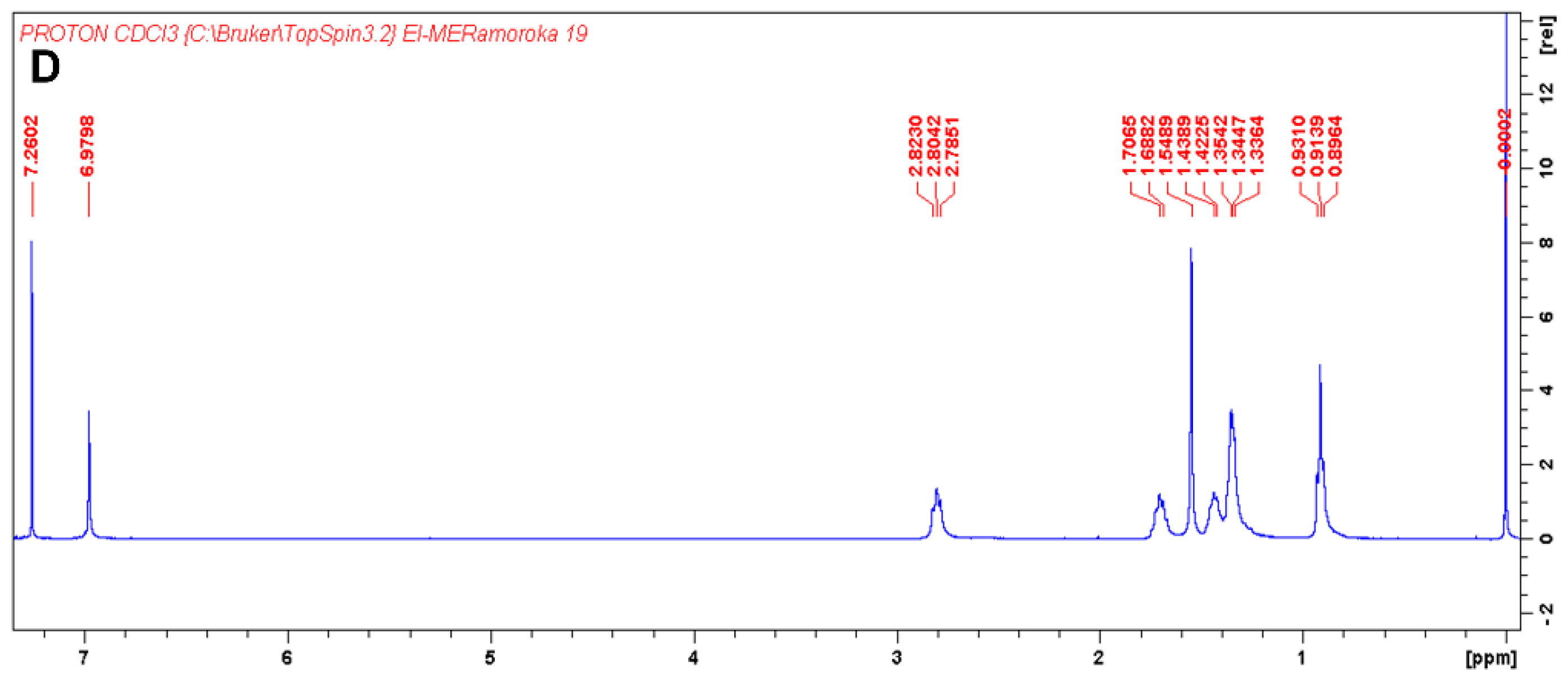
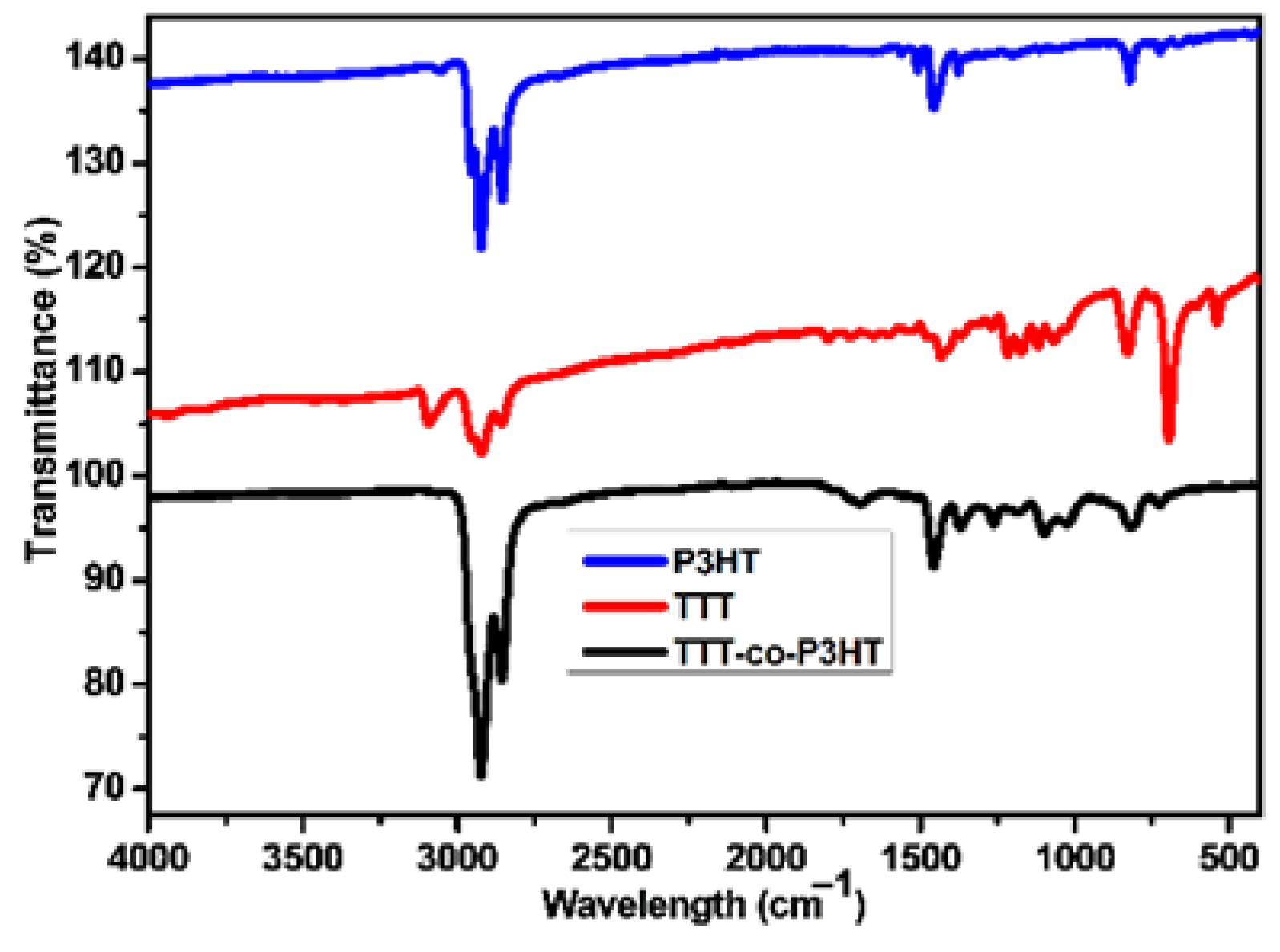

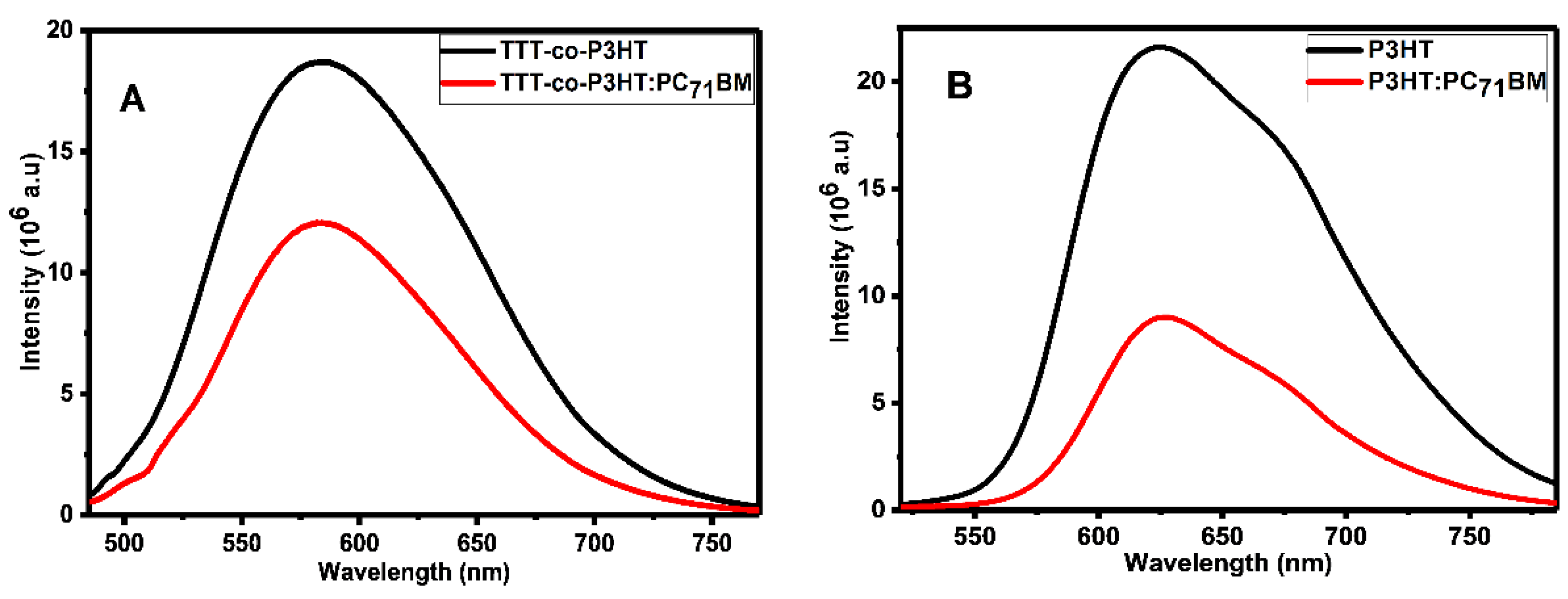

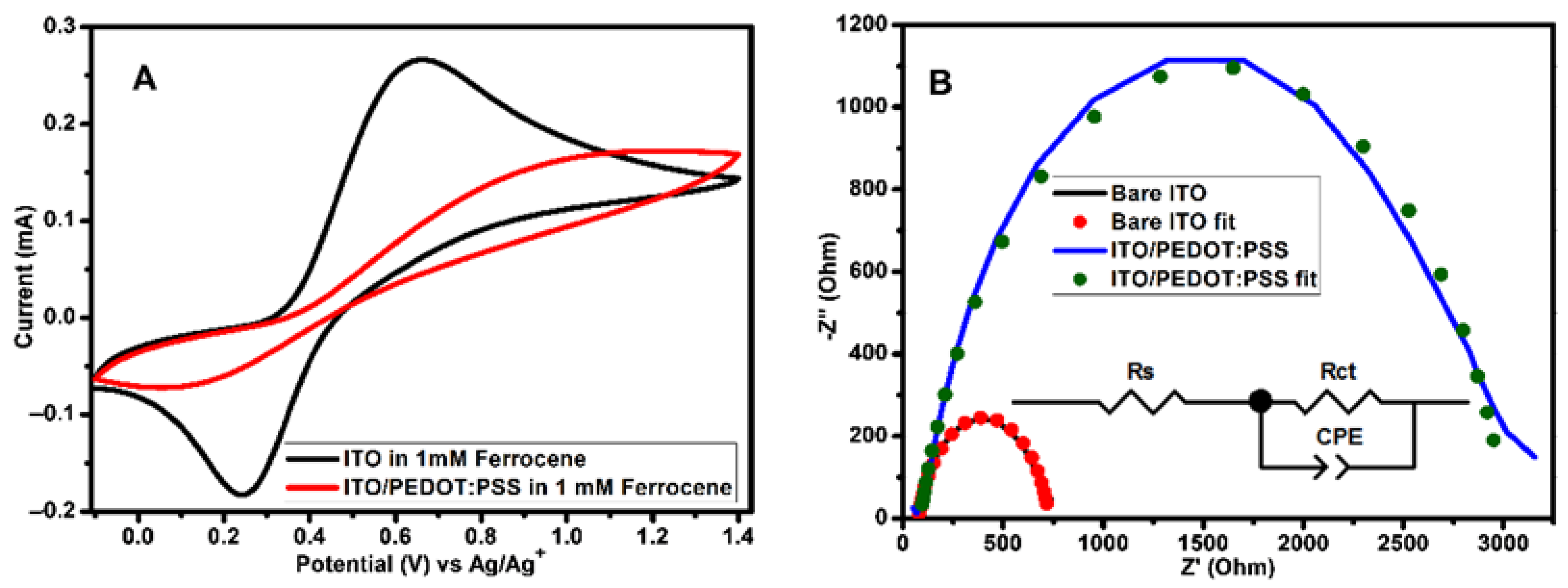

| Polymer | Mn (g·mol−1) | Mw (g·mol−1) | Mp (g·mol−1) | Mz (g·mol−1) | Polydispersity Index | Mz/Mw |
|---|---|---|---|---|---|---|
| TTT-co-P3HT | 15,131 | 54,421 | 38,613 | 157,867 | 3.60 | 2.90 |
| Polymer | a λ (nm) | c Egoptical (eV) | b λ (nm) | c Egoptical (eV) | d EHomo (eV) | d ELumo (eV) | e EgCV (eV) | ||
|---|---|---|---|---|---|---|---|---|---|
| Max | Onset | Max | Onset | ||||||
| TTT-co-P3HT | 386 | 534 | 2.32 | 492 | 626 | 1.98 | −5.09 | −2.90 | 2.19 |
| P3HT | 458 | 561 | 2.21 | 516 | 650 | 1.91 | −4.90 | −2.93 | 1.97 |
| Active Layer | Jsc (mA/cm2) | Voc (V) | FF (%) | PCE (%) |
|---|---|---|---|---|
| TTT-co-P3HT:PC71BM | 1.27 | 0.41 | 26.78 | 0.14 |
| P3HT:PC71BM | 7.91 | 0.46 | 31.64 | 1.15 |
| Rs (Ω) | Rct (Ω) | CPE-T (μF) | CPE-P (n) | |
|---|---|---|---|---|
| ITO | 75.57 ± 0.06 | 655.10 ± 4.05 | 19.33 ± 0.51 | 0.82 ± 0.01 |
| ITO/PEDOT:PSS | 85.31 ± 2.15 | 2935.00 ± 39.65 | 18.53 ±0.68 | 0.82 ± 0.01 |
| a Ipa (without) mA | b Ipc (without) mA | c Ipa (with) mA | d Ipc (with) mA | e Idecreased (pa) | f Idecreased (pc) | |
|---|---|---|---|---|---|---|
| TTT-co-P3HT:PC71BM | 0.28 | −0.17 | 0.19 | −0.12 | 0.32 | 0.29 |
| TTT-co-P3HT:PC71BM/ZnO | 0.20 | −0.12 | 0.15 | −0.09 | 0.25 | 0.25 |
| P3HT:PC71BM | 0.27 | −0.21 | 0.21 | −0.15 | 0.22 | 0.29 |
| P3HT:PC71BM/ZnO | 0.29 | −0.23 | 0.15 | −0.11 | 0.48 | 0.52 |
Publisher’s Note: MDPI stays neutral with regard to jurisdictional claims in published maps and institutional affiliations. |
© 2020 by the authors. Licensee MDPI, Basel, Switzerland. This article is an open access article distributed under the terms and conditions of the Creative Commons Attribution (CC BY) license (http://creativecommons.org/licenses/by/4.0/).
Share and Cite
Ramoroka, M.E.; Mdluli, S.B.; John-Denk, V.S.; Modibane, K.D.; Arendse, C.J.; Iwuoha, E.I. Synthesis and Photovoltaics of Novel 2,3,4,5-Tetrathienylthiophene-co-poly(3-hexylthiophene-2,5-diyl) Donor Polymer for Organic Solar Cell. Polymers 2021, 13, 2. https://doi.org/10.3390/polym13010002
Ramoroka ME, Mdluli SB, John-Denk VS, Modibane KD, Arendse CJ, Iwuoha EI. Synthesis and Photovoltaics of Novel 2,3,4,5-Tetrathienylthiophene-co-poly(3-hexylthiophene-2,5-diyl) Donor Polymer for Organic Solar Cell. Polymers. 2021; 13(1):2. https://doi.org/10.3390/polym13010002
Chicago/Turabian StyleRamoroka, Morongwa E., Siyabonga B. Mdluli, Vivian S. John-Denk, Kwena D. Modibane, Christopher J. Arendse, and Emmanuel I. Iwuoha. 2021. "Synthesis and Photovoltaics of Novel 2,3,4,5-Tetrathienylthiophene-co-poly(3-hexylthiophene-2,5-diyl) Donor Polymer for Organic Solar Cell" Polymers 13, no. 1: 2. https://doi.org/10.3390/polym13010002
APA StyleRamoroka, M. E., Mdluli, S. B., John-Denk, V. S., Modibane, K. D., Arendse, C. J., & Iwuoha, E. I. (2021). Synthesis and Photovoltaics of Novel 2,3,4,5-Tetrathienylthiophene-co-poly(3-hexylthiophene-2,5-diyl) Donor Polymer for Organic Solar Cell. Polymers, 13(1), 2. https://doi.org/10.3390/polym13010002





